Welcome back!
What a fabulous first week back! We loved seeing your holiday photographs and finding out about your adventures to parks, playgrounds and Piglets Adventure Farm.
This week, we have certainly made the most of the beautiful, sunny weather. In our outside area, we noticed lots of catkins had fallen off the tree. Children loved gathering them together and mixing them with sticks, petals and leaves. We had lots of different recipes and creations to try, ranging from vegetable soup to chocolate cake and ice-cream. Yum yum!
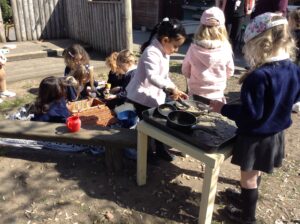
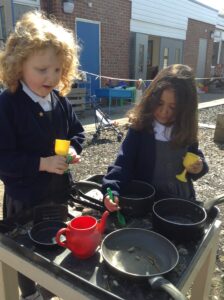
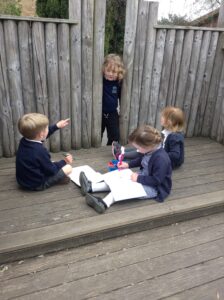
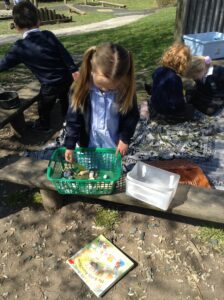
We also listened to lots of stories with our friends, created our own music, had a picnic and played football.
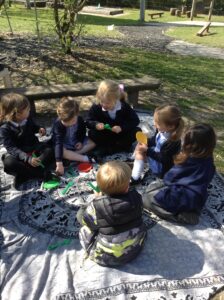
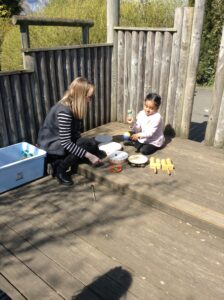
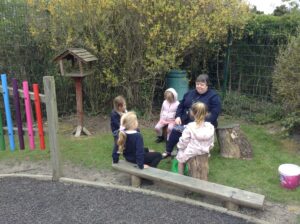

Our obstacle course was very popular; you’ll see lots of engaged and happy faces in the photographs.
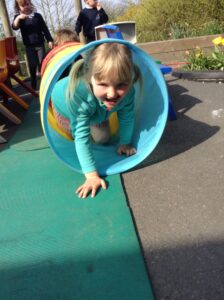

Physical Development is one of the Prime areas of the Early Years Foundation Stage so we’re always looking for different ways to allow children to challenge themselves and develop their balancing, climbing and movement skills. There was lots of team work, with children waiting for their turn and encouraging each other as they moved around the course. It was lovely to hear some children proudly shout, “Look at me!” as they managed to balance on one leg independently or walk over the wobble board without falling off.


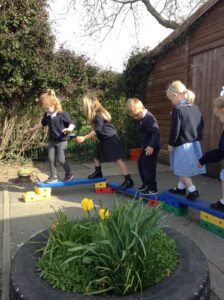
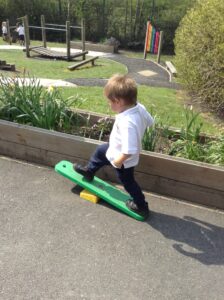
As we were outside so much, lots of children spotted different flowers that had grown in the garden. We looked at the different coloured tulips and tried to guess the colour of the petals what were yet to open from their buds. As well as flowers, there was a lot of interest in all of the bugs that seemed to be out and about this week! Miss Backhouse found a green caterpillar, Mrs Long found a beetle and Mrs Beesley spotted lots of insects flying around on Thursday.
Over the next few weeks, we will learn all about different minibeasts, starting with one of our favourite stories, ‘The Very Hungry Caterpillar’. We’re sure you’ll be familiar with this one, but if you don’t have a copy to read, here’s a link to listen at home.
Reminders
- Please ensure that your child’s water bottle has their name on.
- If your child has a packed lunch, please make sure that you follow our ‘Guide to Healthy Packed Lunches‘ and save chocolate bars and sweets for home.
Sunny days
Your child will need a NAMED sun hat in school everyday. On sunny days, sun cream should be applied before children come to Nursery. If your child’s sun cream requires it to be re-applied after lunch, please put a NAMED bottle of sun cream in their group’s water bottle basket on the days that you would like it to be re-applied.
Finally, congratulations to Miss Whitaker, who got married during the holidays. Mrs Crompton enjoyed telling children all about her wedding day and even brought in her dress and flowers for us to see!
3,4 NV class news
Well done for a fabulous week back! You have worked really hard.
This afternoon, we have enjoyed learning how to operate Scratch Junior. We are learning how to get our sprites moving and even talking to each other. Over the course of the half term , we will continue to design, write and debug our own games and challenges.







Next Friday (30th April), we will be working as class to celebrate and raise money for the Captain Tom 100 challenge. As a class, we have voted to participate in 100 minutes of WUSU! Please help us raise money – a suggested donation would be 100p. We can’t wait to get dancing!
Enjoy the sunshine.
5/6 Certificate Celebration
This weeks certificate winners are…
For great learning…
William W – for great learning in computing. You worked hard to create your algorithm and even manged to debug your program when it didn’t work. Well done!
For sport and physical activity…
Dasha – you participated in rounders really well this week and your throwing has really improved and is more accurate now. Well done!
For living and learning…
Connor – you always remember to use your manners whatever you are doing. Well done and thank you.
Well done everyone!
Captain Tom 100 Challenge
Welcome back to Summer Term – we’ve had a cracking week! The weather is sunny and warm, and it’s making us feel inspired to leap into action.
We’re going to get started on some fundraising next week. Friday 30th April sees a campaign organised by the Captain Tom Foundation. This date marks a year from when Sir Captain Tom began the 100 laps around his garden. To mark this occasion, people are being encouraged to complete a challenge based on the number 100. We are definitely up for this challenge! Every class will be discussing and choosing their challenge.
In Year 3/4, we took a vote on many good ideas, and the vote with the most votes was …to shoot 100 basketball baskets in 100 minutes.
But that sounds easy? Oh no! We’re setting ourselves this challenge to do in pairs, or individually, over 100 minutes throughout the day.
We will be asking for voluntary donations to support the children in their challenges. This money will be ready to be donated to our new charity as soon as it’s selected.
Thank you in advance of your support and wish us luck with our challenges
Living and Learning: saying please and thank you
This week, we have been making an extra effort to use our manners.
We know that using simple words and phrases like please and thank you can make a big difference.
Being polite to everyone is very important and can really brighten someone’s day. This links very well to one of our school rules:
We respect everyone and everything.
Captain Tom 100 Challenge 5/6M
On the 30th April 2021, children in 5/6M will be joining the Captain Tom 100 Challenge.
In the morning, our class will write 100 joyful messages and pictures which will be hidden around the school grounds. Other children from our school community will be invited to find and read as many as they can throughout the day.
Please support us in this challenge by donating 100 pennies (or £1) for the new school charity.
Captain Tom 100 Challenge


Year 5/6B will be completing a challenge on Friday 30th April to raise money for our school charity. Throughout the day, we will be running around our school field – 100 times! We are hoping that parents will donate £1.00 in order to support us in this challenge. Can you please make sure your child has a water bottle to bring to school with them.
5/6B will do you proud!
Captain Tom 100 Challenge

Year 5/6 S are very excited to announce what challenge we will be completing on Friday 30th April to raise money for our school charity. Over the course of the day, we will be running for a total time of 100 minutes! We are going to be exhausted, but it will be worth it! We are hoping that parents will donate £1.00 in order to support us in this challenge. Thank you in advance of your generosity.
Creative Computing!
Year 5 and 6 have been computing hero’s this week in topic. They have been using Scratch on the laptops to create their own programs. They used algorithms to program the sprite to draw different shapes. They started off by drawing a circle and an equilateral triangle. They then moved onto creating a spirograph design. All of these processes involved the children using logical reasoning to debug their algorithms when it didn’t create the shape they wanted. They also used the skill of repetition to allow them to be more efficient. Ask your child at home about their computing learning. Can they remember any of the vocabulary we’ve been learning? There were some great designs – well done!


Captain Tom 100 Challenge
Welcome back after the Easter break.
The brand new Junior Leadership Team are going to be very busy this half term and they’re ready for action! In the next few weeks, classes will be coming up with ideas for who our next school charity will be. The JLT will then make the final decision. Before we even do this though, we’re going to get cracking on some fundraising. Friday 30th April sees a campaign organised by the Captain Tom Foundation. This date marks a year from when Sir Captain Tom began the 100 laps around his garden. To mark this occasion, people are being encouraged to complete a challenge based on the number 100. We are definitely up for this challenge! Each class will be discussing and choosing their challenge. This could be based on a maths challenge, running 100 metres or even writing a 100-word poem. We will be asking for voluntary donations to support the children in their challenges. This money will be ready to be donated to our new charity as soon as it’s selected. Each class will be posting on the website their chosen challenge.
Thank you in advance of your support and good luck with all the challenges.

